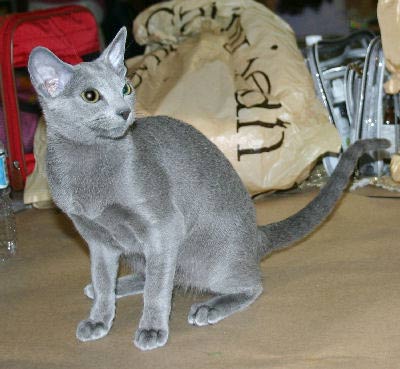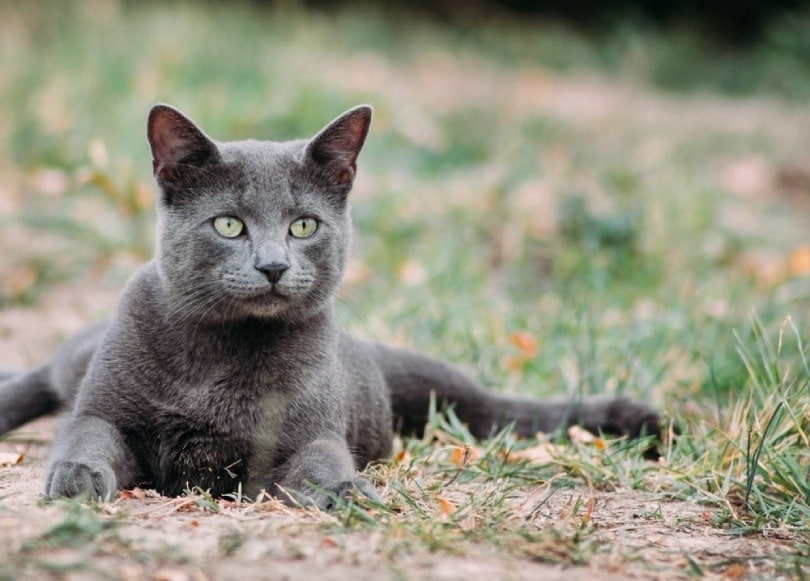
The lovely Russian Blue, nothing is more luxurious than its rich, thick, silver-sheen blue coat!
This elegant, sleek cat is a breed of romantic legends. Fantastical speculations of the origins of the Russian Blue Cat start from the time of the Vikings, to a ships’ cat, the Archangel Cat, sailing the White Seas. It’s also found in a Russian legend, being a cat of special qualities bestowed upon it as it became the nursemaid to an infant princess gifted by the fairies. Thus it became the beautiful gifted creature that has evolved for all of us to enjoy and love today. But in a bit more practical sense, this breed may have originated from Russia, Archangel, or Norway. It is now very prominent around the world.
The Russian blue is known for its affection and serene disposition. It is well-loved for its elegant, yet simplistic appearance. It has a slender, elongated yet muscular body and a long, thin tapering tail. This cat breed is known for its gorgeous blue coat, a light to dark gray with a silvery sheen. There are also some variations of white, black and red that are accepted in some countries. This breed requires little grooming, yet remains stunning at all times.
This is an extremely affectionate cat breed. The Russian Blue cat loves being around people, including strangers, and other cats. It is known for being quite gentle and serene, however some have also described it as a temperamental cat. It enjoys staying inside and can be either playful or sedentary, depending on its particular personality. These qualities make it great for either a quiet home, where it can relax, but is also suited to family life, since it is relatively easy going. The Russian Blue is also known for being less destructive than other breeds. It has a very soft, sweet voice and requires little maintenance.
For information about keeping a pet cat, see:
Cat Care: How to Take Care of a Cat
- Kingdom: Animalia
- Phylum: Chordata
- Class: Mammalia
- Order: Carnivora
- Family: Felidae
- Genus: Felis
- Species: domesticus
Background
Several theories exist explaining the origins of the Russian Blue Cats.
- The first states that this breed originated in the northern parts of Russia. The theory further states that the breed adapted to the cold climate by developing a short, thick, double coat. The breed was kept by the Vikings, and eventually brought to Britain. This theory is responsible for the first part of the breed’s name.
- The second theory suggests that the cats were taken from the port of Archangel (now known as Archangel’sk), on the White Sea, as ships’ cats, to Sweden and then to Britain.
- The third theory states that they may have come from northern Norway to Britain.
- The fourth theory envisions them as being taken from Archangel by visiting British sailors.
- An interesting Russian fairy tale that also attempts to explain the breed’s origin is as follows: Seven fairies gathered around a baby princess’s cradle to give her seven gifts. One gave her a fearless spirit, another a loyal heart, the third said she would be slim and beautiful all her life, the fourth that her every movement would be graceful, the fifth said she would always wear silver, silk, and velvet, the sixth brought her two huge emeralds, and the seventh said she would find friends wherever she went in the world. However, these fairies were rather young and inexperienced at bestowing gifts and they could not believe this tiny red screaming baby would ever grow into a beautiful princess. So they gently placed their gifts in another crib where there was only quiet purring. And that is how the Russian Blue came to be such a particularly beautiful and gifted cat!
No matter what its exact origins were, the Russian Blue became a popular breed by the late 1800’s. However, it was shown as the same breed as the British Blue in its early years. The combining of the breeds stirred controversy, since Russian Blues were sure to fall short of British Blue standards, even if they met every standard of a model Russian Blue.
In 1912 they were awarded a separate category, though it was under the less desirable name of “Foreign Blue”. Finally, in 1939 the breed’s name was reinstated as “Russian Blue”. After World War II, when the breed was nearly lost, breeders introduced Siamese lines into the breed. But around 1965 British breeders attempted to reverse the trend so that the British Blue no longer looked like an all-blue Siamese. The Russian Blue arrived in America around 1890.
The common names for this natural breed cat are as diverse and far-reaching as the stories of its origin. They include Russian Blue Cat, Russian Shorthair, Archangel Cat, Archangel Blue Cat, Foreign Blue Cat, Maltese Cat, Blue Maltese Cat, Chartreuse Blue, Russo-American Blue, Spanish Cat, Spanish Blue Cat, and Blue Russian Cat.
Description
The Russian Blue has a medium-size, slender, elongated, and well-muscled body. The legs are long and slender with round paws. The tail is long, thin, and tapering. The head is wedge-shaped and of medium size. In Britain, the head is rounder than in America. The eyes are large, almond-shaped, and green. The nose is medium length and the ears are large, wide-set, and moderately pointed. The Russian Blue’s weight ranges from 7 to 12 pounds, though it is slightly heavier in Britain. They live to be approximately 13 to 15 years old.
Obviously, this breed is known for its blue coat, which can range from light to dark gray with a silvery sheen. However, White, Black, and Red variations are accepted in some countries. They are referred to as Russian Whites, Russian Blacks, and Russian Reds. The coat is short and dense, due to the double coat, consisting of an outer coat of strong guard hairs and an inner coat of water-resistant down hairs.
Care and Feeding
No special diet is needed, unless the cat becomes overweight, which is not unheard of with this breed.
Housing Your Cat
This breed can survive indoors or outdoors, though many individuals enjoy spending most of their time indoors. This is an ideal apartment cat. However, it can also withstand the harsh, cold weather of northern regions, due to its thick double coat.
Maintenance
The Russian Blue requires minimal grooming. Some owners even claim that the longer one waits to brush it, the more radiant the coat becomes.
Social Behaviors
This cat loves being around people and other animals. It is especially affectionate with its mate. It may be happiest in a quiet home, where it can relax and observe silently. However, its tranquil nature also suits it well for family life, since it will not be greatly aroused by others.
Activities
This breed can be playful or lack the need for activity. However, it can be prone to becoming fat. If it becomes overweight, it should be encouraged to play and exercise.
Breeding/Reproduction
Since Russian Blues are especially affectionate cats, they are well suited for mating and parenting. Litters generally contain four kittens.
Common Health Problems
This is an especially hardy cat with few ailments. However, some may overeat, especially when presented with dry food, which can cause vomiting.
Availability
Russian Blues are available from breeders on the internet and found locally. Prices range from $375 to over $1000.
References
Featured Image Credit: ddisq, Shutterstock
